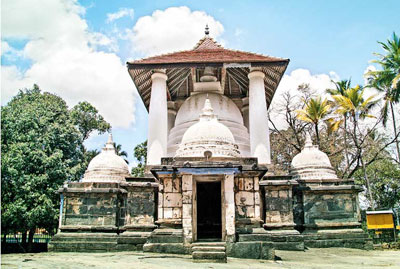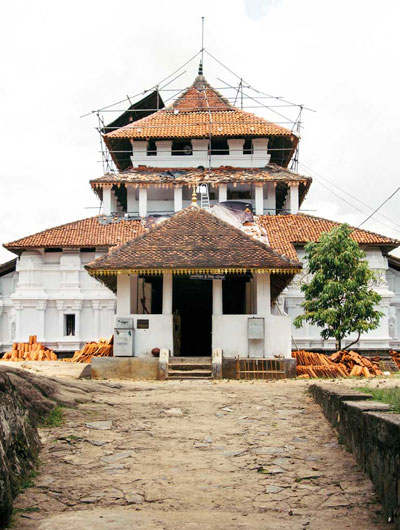75th Independence
From glorious kingdoms to foreign rule
View(s):- Renowned archaeologist Dr. Senarat Paranavitana in his book ‘Sinhalayo’ details the
beginning of the decline of Sri Lanka’s ancient kingdoms
From the beginning of the fourteenth century, the ancient irrigation system was gradually neglected. The lands which were irrigated by it relapsed into jungle, and the bulk of the population in these areas either perished of warfare, sickness and famine or moved into other areas. The ancient capitals, Anuradhapura and Polonnaru, were deserted and the splendid monuments with which they were adorned became the prey of the advancing jungle tide.

The Gadaldeniya temple: A 14th century architectural monument
The seats of Sinhalese royalty were shifted to the mountainous regions in the centre of the island or the western seaboard. The mainstay of the economy of the state after the twelfth century was cinnamon, for which Arab merchants visited the shores of the Island. Two remarkable architectural monuments were built in the middle of the fourteenth century, in spite of the decline in prosperity which the country witnessed as a whole.
Of these, the Lankatilaka in the vicinity of the then royal seat Gampola, mainly of brick construction, was a natural development of the Polonnaru architecture modified to some extent by influences from Burma. The other edifice at Gadaladeni, not far from Lankatilaka, was in the Dravidian style of South India, but with the stupa in place of the sikhara to indicate the Buddhist nature of the cult to which the shrine was dedicated. The Natha Devale at Kandy is a building of the same type.
In spite of the decline in the economic and political spheres, Ceylon continued to maintain the reputation which it had earlier gained in Southeast Asia as a land where the doctrines and practice of Theravada Buddhism have been preserved in their pristine purity. The existing organisation of the Buddhist religion in Siam and Cambodia has been largely due to intercourse with Ceylon in the fourteenth and fifteenth centuries. This also profoundly influenced the religious history of Burma.
Alakesvara in the last quarter of the fourteenth century, and Parakramabahu VI in the middle of the fifteenth, unified the political authority in the Island by vanquishing the Arya Cakravarti — ruler of Jaffna — but on neither occasion did the unification last very long. There was a rapid decline after the reign of Parakramabahu VI, and when the Portuguese came on the scene at the beginning of the sixteenth century, they were able to establish their authority by taking the side of one of the warring Sinhalese factions, namely the King of Kotte, the suzerain of the other rulers in the Island.
The people of the highlands with Kandy as their capital valiantly defended their independence for two centuries against the Portuguese and the Dutch, who, one after the other, ruled the maritime provinces. But in 1815, the opposition of the Kandyan nobility to the Nayakkar king who was on the throne, gave the opportunity to the British to become masters of the highlands and establish their rule over the whole island.

Lankatilaka: Polonnaruwa architecture modified by Burmese influence

